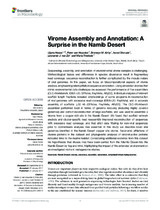| dc.contributor.author | Hesse, Uljana | |
| dc.contributor.author | Van Heusden, Peter | |
| dc.contributor.author | Kirby, Bronwyn | |
| dc.contributor.author | Olonade, Israel | |
| dc.contributor.author | van Zyl, Leonardo Joaquim | |
| dc.contributor.author | Trindade, Marla | |
| dc.date.accessioned | 2017-03-13T07:22:09Z | |
| dc.date.available | 2017-03-13T07:22:09Z | |
| dc.date.issued | 2017 | |
| dc.identifier.citation | Hesse, U. et al. (2017). Virome assembly and annotation: A surprise in the Namib Desert. Frontiers in Microbiology, 8: Art. #13 | en_US |
| dc.identifier.issn | 1664-302X | |
| dc.identifier.uri | http://hdl.handle.net/10566/2621 | |
| dc.identifier.uri | http://dx.doi.org/10.3389/fmicb.2017.00013 | |
| dc.description.abstract | Sequencing, assembly, and annotation of environmental virome samples is challenging. Methodological biases and differences in species abundance result in fragmentary read coverage; sequence reconstruction is further complicated by the mosaic nature of viral genomes. In this paper, we focus on biocomputational aspects of virome analysis, emphasizing latent pitfalls in sequence annotation. Using simulated viromes that mimic environmental data challenges we assessed the performance of five assemblers (CLC-Workbench, IDBA-UD, SPAdes, RayMeta, ABySS). Individual analyses of relevant scaffold length fractions revealed shortcomings of some programs in reconstruction of viral genomes with excessive read coverage (IDBA-UD, RayMeta), and in accurate assembly of scaffolds ?50 kb (SPAdes, RayMeta, ABySS). The CLC-Workbench assembler performed best in terms of genome recovery (including highly covered genomes) and correct reconstruction of large scaffolds; and was used to assemble a virome from a copper rich site in the Namib Desert. We found that scaffold network analysis and cluster-specific read reassembly improved reconstruction of sequences with excessive read coverage, and that strict data filtering for non-viral sequences prior to downstream analyses was essential. In this study we describe novel viral genomes identified in the Namib Desert copper site virome. Taxonomic affiliations of diverse proteins in the dataset and phylogenetic analyses of circovirus-like proteins indicated links to the marine habitat. Considering additional evidence from this dataset we hypothesize that viruses may have been carried from the Atlantic Ocean into the Namib Desert by fog and wind, highlighting the impact of the extended environment on an investigated niche in metagenome studies. | en_US |
| dc.language.iso | en | en_US |
| dc.publisher | Frontiers Research Foundation | en_US |
| dc.rights | Copyright © 2017 Hesse, et al. This is an open-access article distributed under the terms of the Creative Commons
Attribution License (CC BY). The use, distribution or reproduction in other forums
is permitted, provided the original author(s) or licensor are credited and that the
original publication in this journal is cited, in accordance with accepted academic
practice. No use, distribution or reproduction is permitted which does not comply
with these terms. | |
| dc.subject | Atlantic Ocean | en_US |
| dc.subject | Circovirus | en_US |
| dc.subject | Data analysis software | en_US |
| dc.subject | DNA flanking region | en_US |
| dc.subject | Filtration | en_US |
| dc.subject | Metagenome | en_US |
| dc.subject | Phylogeny | en_US |
| dc.subject | Virus genome | en_US |
| dc.title | Virome assembly and annotation: A surprise in the Namib Desert | en_US |
| dc.type | Article | en_US |
| dc.privacy.showsubmitter | FALSE | |
| dc.status.ispeerreviewed | TRUE | |
| dc.description.accreditation | ISI | en_US |

